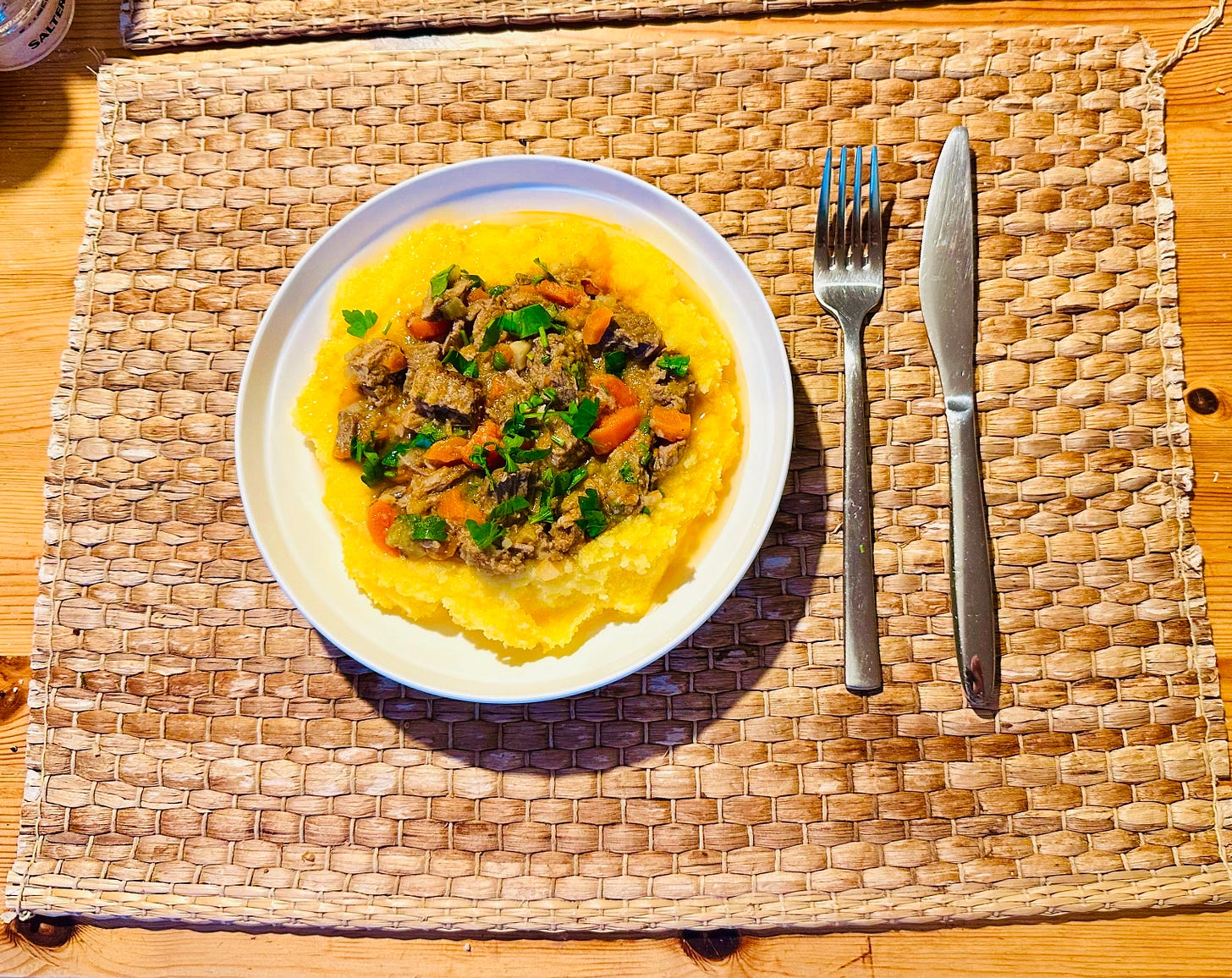Musings, a walk and a little beef story
How kitchen mishaps make for amazing dishes
I am walking down a quiet street in my neighbourhood on what’s supposed to be a spring day. Flash news: it feels like anything but that.
It's cold and grey outside, and my bundled-up body mourns last week’s sun. Yet, amidst the grey, budding pink magnolia trees stand defiant against the cold. Daffodils dot lawns in bright yellow bursts, and a lone bird chirps loudly, its song acting like a balm for my worked-up nervous system.
After wrestling with a draft for days — a post I had hoped would launch a series called Breaking the Fast — I finally broke ties with my laptop. My mind had become cluttered with too many ideas, and each draft iteration felt more forced than the last.
Sometimes, trying to polish something too much strips away its character — like those grocery store fruits and vegetables that look suspiciously perfect but taste like disappointment. I needed clarity, perspective and perhaps some inspiration, so I did what works best when I get stuck: I took a long walk.
As I wandered through my neighbourhood, I brooded on what I’d like this publication to be, what authentic writing means to me, and how I can bridge conversations of comforting bowls of soup with scientific bits like cold adaptation. This train of thought has been on my mind for days, and it’s safe to say just one walk couldn’t give me an answer. Perhaps it would naturally reveal itself to me in the days to come, —who knows?
What is your process or habit for finding clarity when stuck? Let me know in the comments.
The chill in the air eventually drove me homeward, my musings about food writing giving way to more immediate physical needs.
When I got inside, it was nearly 5:30 p.m., and I realised I hadn’t even started thinking about dinner. I was darn hungry and craved a hearty meal, —something comforting and nourishing like beef stew.
So I surveyed my kitchen pantry and fridge and found I have just enough ingredients to get me started: parsnips, carrots, red onions, celery, garlic—and well, diced beef.
In the UK, packaged meats often come with preparation instructions printed on them—a helpful guide for some, but an unnecessary distraction for me. As someone who loves to cook intuitively, these instructions are likely to be ignored most of the time.
Which reminds me of a friend (you know who you are) I used to mentor in cooking. He would ask for advice on how to do something; I’d patiently explain why some steps had to be done a certain way or how flavours could be layered — and then he’d go off and do his own thing anyway.
I found it hilarious and frustrating altogether, and wondered, “Why ask if you aren’t going to listen?” But over time, I realised his approach wasn’t wrong—it was just different. He was experimenting, learning by doing (his own mistakes) rather than by following rules. And isn’t that the essence of cooking?
Holding onto that thought, I started preparing my stew. Instead of cooking it on the stove as I usually do, I resolved to try something different: slow-cooking it in the oven at a low temperature. The idea was simple—let low-temperature heat work its magic until the meat becomes melt-in-your-mouth tender.
A near disaster turned delight
But then reality hit me hard: this method requires patience—three to four hours of patience, depending on the cut and quantity of meat. Even the packaging confirmed this (not that I’d bothered to check earlier).
In disbelief and hungry, I decided to make myself a quick dish of salmon with quinoa and sautéed vegetables while the stew was cooking in the oven.
Two hours and thirty-five minutes into the cooking process, curiosity got the better of me. I cautiously opened the oven door and peered inside the Dutch oven where my stew had been simmering away.
To my horror—and relief—the meat was almost done.
The liquid had mostly been absorbed into the meat and vegetables, leaving behind a rich sauce that clung to each morsel like velvet. Another ten minutes in the oven might have burned everything and ruined the dish beyond saving; my timing had been just right.
I pulled out the pot and didn’t even bother to plate the stew; I ate a few spoonfuls directly from the pot.
To my surprise, it was delicious, so I was thrilled. Tender chunks of beef that practically fell apart at the touch of a fork, vegetables infused with deep umami flavours, a sauce so rich it reminded me of a juicy pulled-pork sandwich I once had at a farm in the UK countryside.
Lessons from the kitchen (and life)
Cooking this stew wasn’t just about making dinner— it became an exercise in embracing imperfection and trusting my intuition. If there’s one thing both cooking and writing have taught me, it’s that trying too hard can stifle creativity.
Whether it’s ignoring package instructions or scrapping yet another draft iteration that feels too polished to be authentic, sometimes you have to let go of expectations to find what you’re looking for.
As I said in my first post, mistakes—or near-mistakes—often lead to some of the best dishes. The stew could have burned, but it didn’t. Instead, it became one of the most satisfying meals I’ve had in the past two months—not because everything went perfectly, but because I allowed room for improvisation.
Now, onto the recipe.
Slow cooked beef stew
Below you’ll find instructions on how you can recreate this beef stew—but remember: recipes are guidelines, not rules.
Mine ended up being in the oven just under 3 hours because I only had 500 g of diced chuck beef, and it turned out incredibly tender and tasty. Even the little connective tissue it contained was cooked nicely too.
Note:You don’t necessarily need to use a dutch oven, any heat resistant casserole pan with a lid works as good.
Let me know in the comments if you try it and how it turns out.
Seves 2
Prep time: 20 mins
Cooking time: 3-4 hrs depending on the beef cut, quantity and how fresh the meat is
Ingredients:
1 red onion (white onion works as well)
1 large parsnip
3 medium carrots
2 celery stalks
1 clove of garlic
1-2 bay leaves
Salt and pepper to season the stew and the flour
1 - 2 teaspoons of ghee / oil
500g diced beef
2-3 tablespoons of buckwheat flour/ regular flour (for flouring the meat)
1 tablespoon tomato purée
700ml beef or vegetable stock
a few sprigs of fresh parsley
Method
Preheat your oven to 160ºC.
Wash the root vegetables and celery stalks and roughly chop them. Peel and dice the onion, then mince the garlic clove.
Heat the ghee / oil in a dutch oven or a casserole pan/oven-resistant pan on medium heat, then add the onions and celery and fry them for 2-4 minutes. Make sure the onion doesn’t burn, we want it nice and translucent. Then add the garlic as well, frying for 1 more minute.
In the meantime, dry out any excess water from the meat with a paper towel, then toss it through the seasoned buckwheat flour. ( This is a trick I learned from Jamie Oliver and honestly, it makes all the difference in the consistency of the stew.)
Next, add the meat to the dutch oven with all the vegetables, bay leaves, tomato puree and the stock, stirring together.
Season well with pepper and a bit of salt (I used Celtic salt for this recipe, but Himalayan or sea salt work as well)
Let it simmer until it comes to boil, then cover it with a lid and place in the oven until the meat is tender. Depending on what cut you’re using and how fresh it is, this step can take 3-4 hours, sometimes under 3hrs.
Close to the 3hr mark, test a piece of meat (if it falls apart easily then you know it’s done).
Let it rest for a few minutes then plate it and garnish it with parsley. Serve with warm bread or polenta.
I hope you’ll enjoy this comforting dish as much as I did. x





People should not be reading your recipes at 10pm when they’re super hungry ☺️. Loved it anyways ❤️